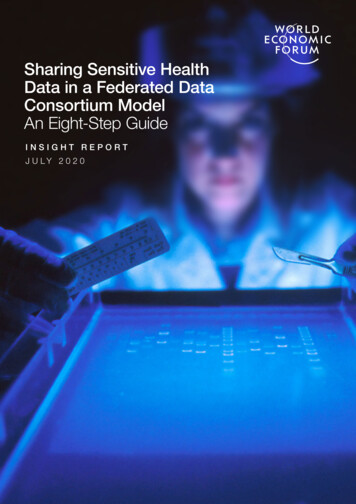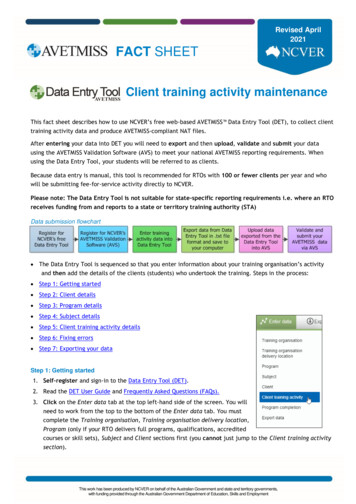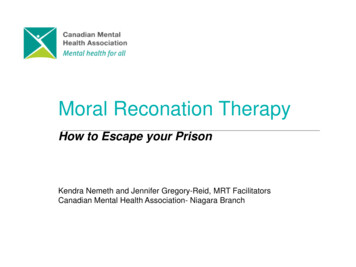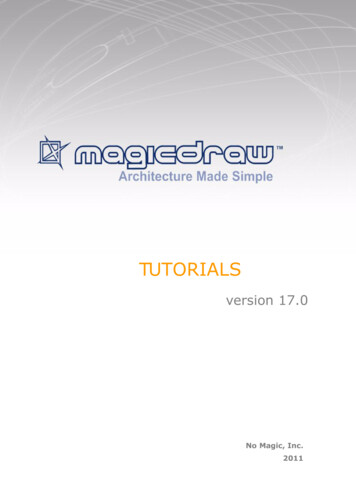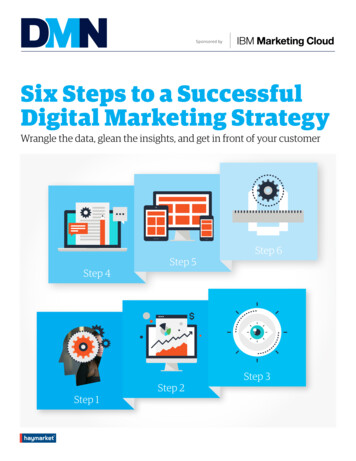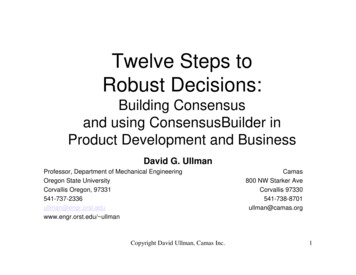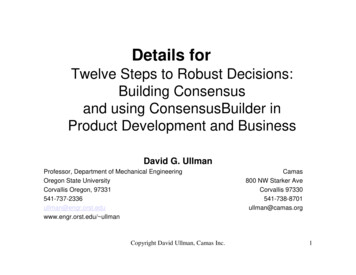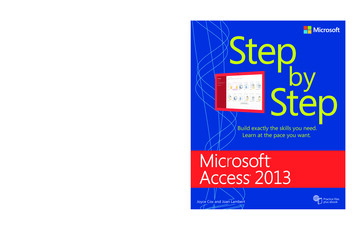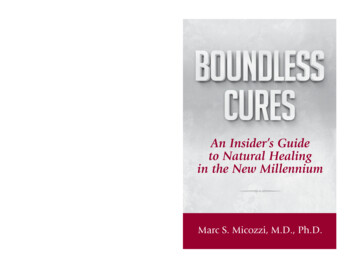
Transcription
taking what’s rightfully yours is already changing the lives of people just like you “You’re making a difference in so many lives,”writes Dan from Scottsdale, AZAnd Marlene couldn’t wait to tell Dr. Micozzi,“I treasure all of your information. I look forward toyour posts like a bear to honey. BLESS YOU.” Step INSIDE a world of NEW CURES ONLINE!www.DrMicozzi.comVisit us online for more Insider informationand resources, including. Breaking news on the latest developments incomplementary and alternative health Written to you by the Insider himself Better answers to today’s most threatening illnessesOV2B000345MicozziYou’ll also find frequently asked questions, articlearchives, and an exclusive Subscribers-Only centerwhere you can search and access back issues.An Insider’s Guide to Natural Healing in the New MillenniumElaine Fisher wrote in to say “Dr. Micozzi, thank you so much for theTRUTH and the diligence.”boundless curesDr. Micozzi’s message ofAn Insider’s Guideto Natural Healingin the New Millennium Marc S. Micozzi, M.D., Ph.D.
BoundlessCuresAn Insider’s Guideto Natural Healing inthe New MillenniumMarc S. Micozzi, M.D., Ph.D.
Copyright 2015, OmniVista Health Media, L.L.C. No part of this publication may be reproduced ortransmitted in any form or by any means, electronic or mechanical, including recording, photocopying,or via a computerized or electric storage or retrieval system without permission granted in writing fromthe publisher. The information contained herein is obtained from sources believed to be reliable, but itsaccuracy cannot be guaranteed.All material in this publication is provided for information only and may not be construed as medicaladvice or instruction. No action or inaction should be taken based solely on the contents of this publication; instead, readers should consult appropriate health professionals on any matter relating to theirhealth and well-being.The information and opinions provided in this publication are believed to be accurate and sound, basedon the best judgment available to the authors, and readers who fail to consult with appropriate healthauthorities assume the risk of any injuries. The publisher is not responsible for errors or omissions.For additional copies or questions, please contact Reader Services at 819 North Charles Street,Baltimore MD 21201. You may also contact us anytime online at www.drmicozzi.com.
Table of ContentsIntroduction.5Part 1: Cancer answers from a true insider.7Ch 1: The “ONE WORD” battle plan to crushing cancer.9Ch 2: The natural cancer secret: vitamin C. . .12Ch 3: Natural treatments beyond vitamin C:An anti-angiogenesis arsenal. . .23Ch 4: Antioxidants for prevention of cancer cell formation.35Ch 5: Immune surveillance: detecting cancer before it strikes.38Ch 6: Combined Effects: Double- and triple-plays with thesefabulous five additional ingredients.44Ch 7: The business of cancer: How more cancer screeningsand the uptick in diagnoses are doing more harmthan good.50Ch 8: Mammograms. . .64Ch 9: The hidden, grisly dangers of “routine” colonoscopies. . .69Part 2: Healing pain instead of treating pain.79Ch 10 Chronic back pain wiped out with asurgery-free treatment.81Ch 11: The problem with pain – another reason thegovernment is literally a pain in the neck.85Ch 12: Managing migraines without drugs.90Ch 13: Why those tired, old natural arthritis “fixes”don’t work .94Ch 14: Rheumatoid arthritis: One of medicine’s mostagonizing mysteries—UNRAVELED!. 100Ch 15: What you need to know about NSAIDs. 104
Table of Contents (continued)Part 3: Brain-healers from behind the curtain. . . 109Ch. 16: The Insider’s Answer for DODGING DEMENTIA. 111Ch. 17: Berberine—the Alzheimer’s answer no onewill pay attention to. 121Ch. 18: Beyond berberine—Your nutrient toolbox forcognitive support. 125Ch. 19: Vitamin E outperforms drug forAlzheimer’s disease. 130Ch. 20: Profits—not cures —for Alzheimer’s disease. 134Part 4: Master your heart health. 137Ch. 21: Shocking results! Not all is as it seems. 139Ch. 22: The ONE prescription I will always recommendfor high blood pressure. . . 144Ch. 23: Starting NOW—Heart healthy relaxation tacticsfrom the “Inside”. 149Ch. 24: Heal your heart with what you eatand how you eat it. 150Ch. 25: The heart disease battle plan: Nine proven secretsfor gaining control . 158Part 5: Conquering everyday health. 165Ch. 26: Natural ways to soothe common digestive issues. 167Ch. 27: The Bear Diet. 179Ch. 28: 10 tips for a balanced diet on a balanced budget. . . 187Ch. 29: Your immune system’s most powerful ally. 191Ch. 30: 10 signs you may have low vitamin D. 193sources.198about the author. . 206
IntroductionHumans possess an innate self-healing potential, an “innerwisdom of the body.” Accessing this self-healing system is theprimary goal of the healing arts. And addressing the cause ofany illness is the first step towards accessing the body’s ownhealing potential. However, modern medicine’s primary focus ison suppressing symptoms instead. The problem is, suppressingsymptoms with pharmaceutical drugs can compromise anddiminish the body’s natural ability to heal itself. Which is whynatural, nonpharmaceutical measures should generally be thefirst approach—not the last resort. Unfortunately, far too manypromising natural therapies—and cures—have been derailed forthe sake of profit and political gain. But in the following chapters,I’ll tell you how you can find these effective treatments—and putthem to use for you and your loved ones starting today.Always on the side of science,Marc S. Micozzi, M.D., Ph.D.5
Part ICancerAnswers froma true insider7
Part 1: Cancer Answers from a true insiderrCh 1: The “ONE WORD” battle plan to crushing cancer.9Ch 2: The natural cancer secret: vitamin C. . .12Ch 3: Natural treatments beyond vitamin C:An anti-angiogenesis arsenal. . .23Ch 4: Antioxidants for prevention of cancer cell formation.35Ch 5: Immune surveillance: detecting cancer before it strikes.38Ch 6: Combined Effects: Double- and triple-plays with thesefabulous five additional ingredients.44Ch 7: The business of cancer: How more cancer screeningsand the uptick in diagnoses are doing more harmthan good.50Ch 8: Mammograms. . .64Ch 9: The hidden, grisly dangers of “routine” colonoscopies. . .698
Chapter 1The “ONE WORD” battle planto crushing cancerUntil this very moment in medical history, the common notionin the mainstream crusade against cancer is: Chemo is as good asit gets.Of course, I’ve always known this was untrue. And if you’vebeen curious enough to poke your head up from the sea of cancermisinformation we’re drowning in, maybe you’ve glimpsed thetruth for yourself.Chemotherapy is a desperate grasping at straws in an effort to“kill the cancer before we kill the patient.” But it also blatantlyignores the mountains of complementary medical research provingthat cancer can be prevented and treated without this.But in the last few years, even some of the most die-hardmainstreamers have taken notice of a new form of cancer treatmentcalled anti-angiogenesis. It’s radically different from the “poisonand pray” chemo approach to treatment. An approach many ofus have had to watch loved ones suffer through. But as you’ll see,the difference in methodology is only the first of many reasonsto have hope.The “AH-HA!” momentmodern medicine was praying forIn 1998, The New York Times created a media frenzy theyreported a scientist by the name of Dr. Judah Folkman haddiscovered a way to eradicate tumors in mice. The frenzy swelled tosuch heights that Nobel laureate, Dr. James Watson was quoted assaying, “Judah is going to cure cancer in two years.” And, in effect,he did. So why haven’t you heard about it over the past decade?Indeed, Dr. Folkman was a special kind of scientist. I admired9
his natural instincts in following the science so much, in fact,that even before the media frenzy in 1998, I personally invitedhim to speak in Philadelphia to a standing-room only crowd ofdistinguished physicians and scientists. (This was when I wasdirector of The College of Physicians of Philadelphia, and I washonored to have him come and enlighten my guests).At that point, Dr. Folkman had already been following thisparticular scientific revelation for over 30 years.It all started with the question how can tumors grow so fastand so aggressively?During his time at the National Naval Medical Center inBethesda, MD, he had noticed cancer cells were unable to organizeinto tumors bigger than a few millimeters in vitro (meaning in testtubes, outside of the body). So somehow tumors were dependentupon the human body for growth.And then he saw it.Your body is being hijackedDr. Folkman was already considered to be the founder ofangiogenesis research, so he knew what to look for. But whatexactly is angiogenesis?It’s your ability to grow new capillary blood vessels in thebody.1 It’s a special process. And in balance, it shouldn’t happen toooften (mostly during menstruation for women, wound healing,and of course, while a fetus is still within the womb).But when the body needs to divert more blood and nutrients toa specific area, it activates endothelial cells in the lining of bloodvessels to release enzymes called proteases. These allow endothelialcells to “bust out” of the current capillary they’re in and form newcapillaries. This ability to form new blood vessels obviously helpswith the healing process, human growth, and supplying muchneeded nutrition throughout your body.10
But it can turn deadly The big break came when Dr. Folkman applied his knowledgeof angiogenesis to cancer research. For decades, researchers hadmarveled at a tumor’s ability to grow exponentially larger in sucha short amount of time. But what if these cancerous tumors wereusing your body to feed themselves and even spread elsewhere?It wasn’t long after that Dr. Folkman proved tumors secreteangiogenesis-inducing factors (mitogens) which cause neighboringnormal capillaries to extend and supply blood to the tumor.2It was an incredible step—one that could eventually lead usaway from the “poison and pray” treatment of chemotherapy,which oncologists appear so eager to administer these days.This single hypothesis spawned nearly uninterruptedbreakthroughs for almost 40 years. It’s the kind of watershedmoment about which every scientist dreams. Two of the biggestbreakthroughs came in identifying a whole family of angiogenicpeptides3 and in showing that once you shut them down, you canchoke tumors out of existence.4What does that mean for you and your family?“Angiogenesis research will probably change the face of medicine inthe next decades, with more than 500 million people worldwide predictedto benefit from pro- or anti-angiogenesis treatments”5That is a quote from the January 2006 issue of Nature—andthey’re right.Anti-angiogenesis therapy is already turning heads in researchfacilities and hospitals all over the world. That’s why over 4 billionhas recently been spent researching anti-angiogenesis, making itone of the biggest medical research initiatives in history.6In fact, there are already 374 clinical trials in the works andvested interests are practically drooling over the profit potential.711
Sadly, Dr. Judah Folkman passed away recently at the ageof 75, but the research he started is now finally thriving. Newangiogenesis inhibitors are being discovered all the time. Doctorsare now witnessing tumors shrink and in some cases witheraway completely. In fact, this therapy should be able to makechemotherapy extinct someday.But the best news is that you don’t have to wait another minuteto start putting this revolutionary technique to work for yourself.As usual Nature is already seventy steps ahead of us And counting. The great news for all of us is that theseangiogenesis revelations have shone light on an entire world ofnatural anti-angiogenesis compounds.Much in the same way you might support your immune systemwith vitamin C, or your joints with Boswellia or your prostatehealth with saw palmetto there are safe and natural ways tosupport your body’s angiogenesis balance.I’ll reveal some of nature’s most powerful—and readilyavailable—anti-angiogenesis treatments in chapter 3. But first,a closer look at one of the most powerful cancer cures everdiscovered—and the insidious story of how it was derailed by thevery people in charge of “protecting” our health.Chapter 2The natural cancer secret: vitamin CThe proven cancer revelation—pushed aside for profits!In 1984, a senior staff scientist for the National Cancer Institute(NCI) and a personal friend of mine was on the verge of a medical12
epiphany. She had gathered towering piles of PROVEN researchregarding a downright ordinary substance. Vitamin C.She was a part of the “crash program” to uncover as much aswe could on the relationship between diet, nutrients, and cancer.And had taken it upon herself to gather and review a decade’sworth of small, very sound studies on vitamin C. And what shefound was staggering.In fact, this tireless researcher reviewed over 46 separateepidemiological studies. She found that 33 of them revealed vitaminC offered significant protection against cancer particularly foresophageal, pancreatic, stomach, lung, and breast cancers.8Thirty-three out of 46. That’s a 71% rate of positive results!And in subsequent studies, vitamin C continues to producejaw-dropping results One study in mice showed vitamin C could rob a tumor of itspower source—literally halting any new growth.9 In the prominent medical journal Prostate, it was reported to bea “potent anticancer agent for prostate cancer cells.”10 It was shown to be a CRITICAL element in your body’s ability toresist neoplasia—the formation of abnormal cells.11Research had even been performed by two-time Nobel laureate,Linus Pauling leading him to controversially proclaim, “Thissubstance can prevent cancer.”Imagine. A real cancer breakthrough sitting right under thenose of the NCI the whole time. And all they had to do was lookbeyond the cutting, burning, and poisoning. To consider safer,natural approaches. And they didn’t even have to look far. Thissecret weapon was found just starting with the basics! Of all things,vitamin C.And yet, tragically, chances are you still haven’t heard thepotential of vitamin C for the prevention and treatment of cancer.13
There was one BIG PROBLEM When this dedicated researcher finished her work, she wentproudly before our political bosses to deliver the revolutionarynews. Was she congratulated? Was she asked to present her findingsto an expanded panel of her superiors? Was she even listened to?No. The National Institutes of Health (NIH), the guardian ofthis nation’s health and wellbeing, wasn’t interested in her findings.They weren’t interested in the success rates, shrinking tumors, orhow amazingly simple, affordable, and effective her discovery was.I know it sounds unbelievable. We’re talking about a seniorscientist, with a stack of credible research in hand. The sheer weightand height of which she actually carried into her superior’s officeto try to convey the potential in person.But the sad truth is the NIH already had a “natural cancerplan.” And vitamin C didn’t fall in line. The “science bureaucrats”ignored a hard-working, dedicated scientist with more-thanpromising results in hand. All because they had already investedthemselves in a plan that would just be too hard to stop.What was so good that they could afford to ignore thiscolleagues’ staggering scientific findings?Beta-carotene. Those two words (and tens of millions ofdollars) single-handedly derailed this nation’s entire medicalestablishment—for decades—from finding a PROVEN cure forcancer. Because in 1984, a monumental initiative was mandated.The goal was to make beta-carotene the cancer treatment darling forthe upcoming century.One study is all it took to get the NIH frothing at the possibilities.Just one study, compared to the stack of research my colleagueuncovered on vitamin C. You see, beta-carotene is a plant-derivedform of vitamin A. And in 1981, an influential English scientist(who had studied in Nazi Germany during their earlier war oncancer) in an influential English scientific journal, simply askeda simple question based on a study showing the higher one’s14
vitamin A levels; the less likely they were to develop lung cancer.You see, beta-carotene was of interest because it’s a water-soluble,plant form, that can be converted in humans to Vitamin A, whichis fat-soluble (and therefore potentially toxic). So, NCI was reallylooking for Vitamin A activity thru giving “safe’ beta-carotene. Ofcourse, we now know that even that thinking was faulty. Manypeople do not convert beta-carotene to Vitamin A at all, or only alittle, or only under certain conditions. SO, beta-carotene can notbe considered a reliable source of Vitamin A from plants. So, theNCI immediately jumped to all the wrong conclusions.12And conveniently for the NIH, there was a synthetic form ofbeta-carotene already on the market. Readily available for testing.So they jumped right in. (Though it’s likely that’s not the onlyreason, which I’ll explain in just a minute.)Flash forward two years and the NIH had issued a large-scaleclinical trial. (The cost of which soared into the tens of millions.)And word had spread to the press that “beta-carotene would saveus all from cancer!”All the while, several colleagues from the USDA HumanNutrition Research Center and I were uncovering evidence of theexact opposite.We actually looked to the past and reviewed a dozen smallerstudies on beta-carotene. And we found no correlation betweenblood levels of beta-carotene and cancer. We also looked at over30 studies following the results of the British Empire CancerCampaign. We looked at the foods that consistently showedprotective effects against cancer. Then we used the latest, stateof-the-art technology to identify the carotenoid content of eachof these foods. And they were not high in beta-carotene. But theywere high in vitamin C and other nutrients.There was essentially no reason for the NCI to “bet” on betacarotene. No reason to proceed with multi-million dollar, taxpayerfunded clinical trials that gave synthetic beta-carotene to peoplealready at increased risk for cancer.15
But it was too late. The NIH had already let word leak out tothe media about their new “darling.” And seemingly overnight,thousands of everyday citizens were taking beta-carotene for cancer.All before a full-scale clinical trial had even started!In fact, once the clinical trial got underway, it was hard toorganize the control group of patients because so many people werealready taking beta-carotene. In the medical science world—that’scounting your eggs long before you even have the chicken But why, oh why was the NIH throwing caution(and a proven cure!) to the wind?Because the reward was just too great. And unfortunately, I’mnot talking about saving lives. When it comes to questionablejudgments taking place in our more “infallible” institutions—alwayslook at the advisory board.In this particular case—a member of one of the National CancerInstitute’s advisory boards happened to be a senior science officer atthe manufacturer of a leading synthetic beta-carotene available atthe time. And there it is. The shameful dots should be easy enoughto connect. If beta-carotene became the “chosen one” amongst theNIH, record profits were guaranteed. Even before results were evergathered, and regardless of what the results showed.All the while, sealing the fate of a TRUE CANCER ANSWER tosit on the shelf, collect dust, and be kept from you.One day I asked another scientist how the NCI could continueto ignore all the evidence about vitamin C. He explained thattwo-time Nobel Prize winner Linus Pauling had given vitamin Ca “bad name.” In the government’s eyes, he was too vocal aboutits benefits. And the NCI couldn’t afford to be seen as “kooky” or“fringy.” Better to be just plain wrong. Meanwhile, Linus Paulingsingle-handedly held as many Nobel Prizes as the entire scientificbureaucracy of NIH put together. But the NCI prefers to be “oftenwrong, but never in doubt.”16
In fact We discovered many things when we began to do research withthe USDA. First, we found that the nutritional quality of foodshad declined drastically each decade during the 20th century rightthrough the 1980’s.Second, almost all the healthy foods that are known to preventcancer in fact are not high in beta-carotene. But we did find thatthese foods are high in vitamin C and a lot of other carotenoidsthat no one had heard of before, including lutein, lycopene, andbeta-cryptoxanthine.13 All powerful nutrients that you can easilystock up on through the green, leafy vegetables you get at thegrocery store.And all the NCI managed to prove, tens of millions of dollarslater, was that beta-carotene did not prevent cancer. And that, infact, cancer could actually increase by over 25% in some whenusing the synthetic, isolated beta-carotene of our friendly drugcompany.14And all along, this flawed approach of the NCI—using thewrong doses, forms, and isolated synthetic nutrients—led tomixed results. Which of course opened the door to criticism bypharmaceutical-led mainstream medical science and oncology.Who continue to argue that nutrition won’t work against cancer.I even went so far as to formally predict the failure of thisflawed approach. I knew it wouldn’t work thanks to my work withthe USDA, who actually knew something about nutrition. So Iwrote up a scientific paper using the flawed and ill-fated exampleof beta-carotene. But my paper got caught up by my “political”bosses at the NCI protecting their cancer empire, covering uptheir ignorance of human nutrition, and their waste of time andtax dollars.Finally, once I left the NCI to work at Walter Reed ArmyMedical Center, and away from my “political” bosses my paperwas published in the Journal of the National Cancer Institute itself.17
Fortunately, the journal is reviewed by non-government scientistsindependent of the NCI itself. And I was awarded the YoungResearch Investigator prize for this work at Walter Reed.It wasn’t until 2002 that there was finally general recognitionamong physicians that using RDA guidelines to treat diseases was notadequate. Thanks to the publication of a pair of papers by Fairfieldand Fletcher in the Journal of the American Medical Association.15The stage was finally set for accepting that nutrients should betaken in adequate doses and in natural combinations in order toprevent and cure diseases such as cancer. Three-quarters of a centuryafter the British initiated their first efforts in the war on cancer.Vitamin C breakthrough forcancer targets tumors at the sourceDespite the best efforts of the Medical Mandarins at theNational Institutes of Health, research on vitamin C and cancer HAScontinued And the results of several new studies have allowedme to bring a lot of thinking and observations from the past 35years together. Into a rare—but very real—honest-to-goodnesscancer breakthrough.There has been a lot of interest in the ability of vitamins andminerals to lower the risk of cancer for many decades. But the waya lot of the research is done just doesn’t get it right. They use thewrong nutrients, the wrong forms of administration, the wrongdoses, for the wrong reasons. Then, if they don’t find a positive result,the “experts” have been all too quick to say, “See, it doesn’t work!”Vitamin C has endured more than its share of this shoddyresearch and scientific bias. Especially when it comes to thisnutrient’s anti-cancer potential.And thanks in large part to this inept research, many “experts”have been warning cancer patients against vitamin C for years.When we began offering high-dose, intravenous vitamin C tocancer patients at Thomas Jefferson University Hospital 10 years ago,18
we first had to prove to a number of hospital review committees thatit would be safe. (It was.) And that it wouldn’t interfere with othertreatments (chemotherapy and radiation). (It didn’t.)And now, a new toxicology study has been performed onintravenous vitamin C. And the results are very revealing.The dose administered was 1 gram (1,000 mg) per minute over4 consecutive days each week for a total of 4 weeks.16That dose—1,000 mg—is more than the government’srecommended daily allowance of vitamin C. And the subjects inthis study got 1,000 mg every minute.Researchers then determined how quickly vitamin C iseliminated from the body. They did this by finding the nutrient’s“half-life.” (Half-life means the time it takes for the concentrationin the blood to be reduced by half. The radiation oncologists whoburn out cancers are familiar with radioactive half-life.)The half-life of vitamin C was measured as 2.0 hours (plus orminus, 36 minutes). In this sense you would think of vitamin Cas “short-acting” if it were a drug. But the clearance time for allvitamin C to be eliminated from the body was 21 days, plus orminus 5 days.I think a possible reason for this difference is that the body(particularly the muscles) acts as a reservoir for vitamin C—andcan take up and store a large amount .But it’s important to note that none of the study participantssuffered any ill effects from this high-dose intravenousadministration of vitamin C.This basic toxicology information is very important. (I wish mycolleagues and I had been authorized to study vitamin C like thisback in the 1980s instead of just looking at carotenoids. Althoughat least we were able to discover the importance of lutein andlycopene at the same time I was exposing the lack of any realevidence for beta-carotene. But I digress )19
The new study also tells us that it is probably impossible toachieve blood levels of vitamin C high enough to treat cancer bytaking oral supplements.IV vitamin C enhances chemoSo that answers the safety question about vitamin C for cancerpatients. But what about the concerns regarding vitamin C’s impacton other cancer treatments?Well, new lab studies show that IV vitamin C actually enhanceschemotherapy drugs like gemcitabine and erlotinib againstpancreatic cancer cells (notoriously difficult to treat).17 Researchersobserved this effect even in cancer cells that are otherwise resistantto gemcitabine treatment.This means doctors may be able to lower the doses of toxicchemotherapy drugs they give their patients if they also administerthem with safe IV vitamin C.So this new (and long overdue) research finally allows us to setaside old myths and misconceptions about administering vitaminC to cancer patients.Of course, even after all of this has been settled, there willundoubtedly be the hardened skeptics who will refuse to believe ituntil someone answers the age-old question “but how does it work?”Well, new scientific research now has that aspect covered too Not just an anti-oxidantEarly theories about the role of vitamin C (ascorbic acid) inpreventing cancer focused on its role as an “anti-oxidant.”But oxidation and anti-oxidants are more complicated than itseems. It all goes back to Chemistry 101: Chemically, any oxidantcan become an anti-oxidant, and any anti-oxidant can becomean oxidizing agent, depending upon the surrounding molecularenvironment, acid-base balance, and other factors.20
And this probably explains why test tube laboratory studiesshowed that high enough levels of vitamin C actually cause directcancer cell death. When ascorbic acid gets so high, it may reverseaction and become an oxidant, or may simply just act as an acid.Which poisons cells.However, in lab studies, vitamin C was also effective againstexperimental tumors even at lower doses that could not kill cancercells directly.So, how does it work? Well, it turns out you don’t have to killcancer cells outright (and risk poisoning yourself).Starve cancer cells to deathThere is a two-stage model of cancer. (This model was key to myown PhD dissertation research, which recognized the importanceof early childhood nutrition in the long-term risk of cancer.) Thefirst stage involves some chemical damage that alters the DNA innormal cells, “mutating” them into individual cancer cells. Thisis called cancer initiation.Then the cells have to grow into actual tumors. This stage iscalled cancer promotion. The ability of cancer tumors to grow(promotion) is based upon them hijacking the body’s bloodsupply—which you know now as angiogenesisAnd it now appears anti-angiogenesis is an importantmechan
diminish the body’s natural ability to heal itself. Which is why natural, nonpharmaceutical measures should generally be the first approach—not the last resort. unfortunately, far too many promising natural therapies—and cures—have been derailed for the sake of


